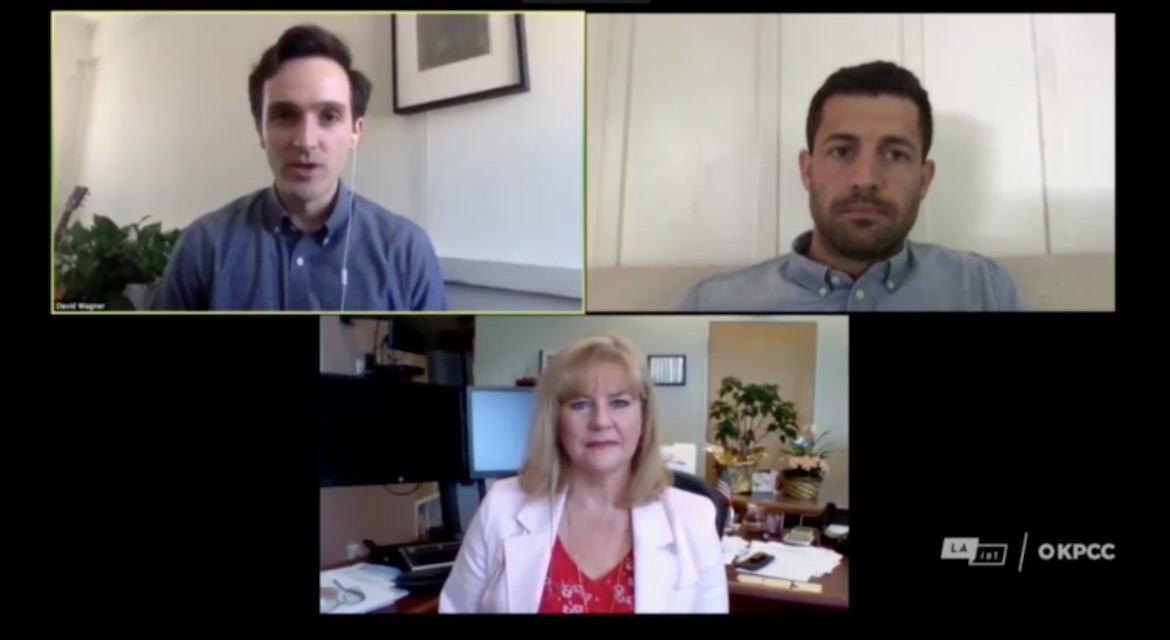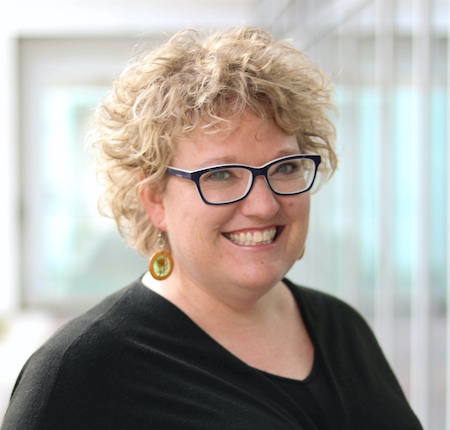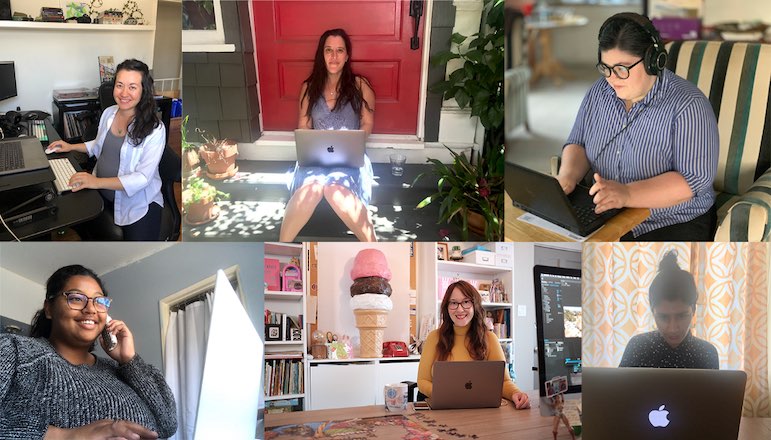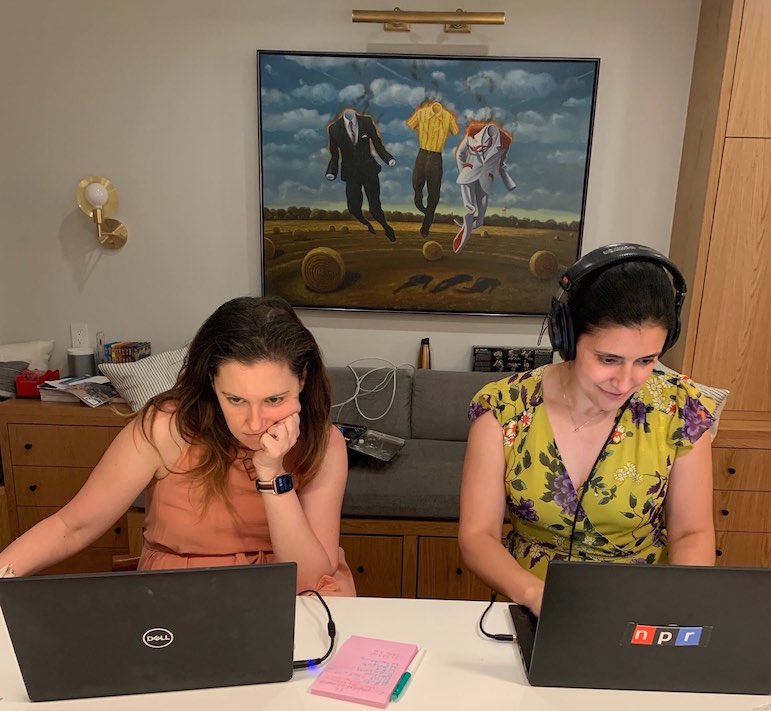Newsrooms ramp up audience engagement tactics for coronavirus coverage

KPCC/LAist Reporter David Wagner, top left, asks audience members' questions about unemployment during a "No Panic Live" event with George Warner, attorney with Legal Aid at Work, and Loree Levy, spokesperson for the state agency that processes unemployment claims in California.
Newsrooms that leaned into audience engagement strategies during the fast-evolving coronavirus health crisis have found new ways to connect with audiences and ensure that their coverage is addressing community needs.
Using tools and tactics that invite audiences to help shape coverage by submitting or responding to questions, public media journalists have sought to learn what information their viewers and listeners are most curious about — and urgently need to know.
From over-the-air callouts for audience input to queries powered by digital platforms such as Hearken and GroundSource, public media’s biggest and smallest news organizations — including NPR, KPCC in Los Angeles, KOSU in Oklahoma City and Next Avenue at Twin Cities PBS — have tried to bring new and more diverse voices to their programming and content. Staff at KPCC, a station with deep experience in audience engagement, say their ongoing efforts are translating into more loyalty and greater support.
The shift toward using audience input in shaping news coverage has been a long time coming, said Joy Mayer, an audience engagement strategist who provides newsroom training. Across all news media, including public broadcasting, journalists have held fast to traditions of making internal decisions on what issues to cover and whom to interview. But Mayer now sees growing awareness of what reporters and editors can learn by inviting more community voices into news reporting.

Mayer, director of the foundation-backed project Trusting News, previously was community manager for Gather, a network and platform for community-focused journalism. “If you’d like to reflect a global crisis, you need to be able to be trusted by people across a spectrum of age, race, education level, income and ethnicity,” she said.
Prioritizing audience engagement requires commitment, focus and a change in hard-wired journalistic processes, all of which are obstacles in most newsrooms, Mayer said. “Hearing from a diverse cross-section of our community … requires new routines, and journalists are creatures of habit,” she said. “It also requires the willingness to have our assumptions challenged about what’s newsworthy and interesting.”
Mayer believes the effort is worth it. “If we do it right, we produce journalism that is more reflective of the public’s voices and experiences, and more responsive to what the people we aim to serve need from us,” she said.
Starting a conversation
Oklahoma’s KOSU, a public radio network with a staff of 11, is using the text-based engagement tool GroundSource to ask questions related to COVID-19. Listeners who respond to a callout on a specific topic receive automatically generated follow-up questions via text messages.
“Texting is a low barrier to entry,” said Andrew Haeg, GroundSource founder and CEO. He sees the medium as an ideal engagement tool because texting is “intimate and personal” and provides a “thrill of immediacy.” Haeg said that out of 42 GroundSource clients, 12 are public media organizations.
In May, KOSU Executive Director Rachel Hubbard and Special Projects Reporter Kateleigh Mills used GroundSource to send out queries about wearing masks as protection from the virus.
With the political divisions and judgments people were making about masks, Hubbard recognized how important it would be to pose questions that would elicit the broadest possible responses from the community. Asking only about the experience of wearing a mask would mean many people would feel excluded and not respond, she said.
As a public broadcaster in a red state, Hubbard knows that many potential listeners perceive NPR as left-leaning. “If we can tear that down just through our questions, we’ve gone a long way,” she said.
So KOSU opted for a series of multiple-choice questions: Do you wear a mask? If so, how often? And had you worn a mask but stopped?
A few people said that wearing a mask made them feel like they were suffocating, Hubbard said. Some described how mask-wearing friends judged them harshly for not wearing one.

“It allowed us to get into nuanced discussions with people that otherwise wouldn’t have happened,” Hubbard said. The query also helped identify sources who were willing to talk at length.
The callout about masking generated the highest response rate of any GroundSource query KOSU has done for its own coverage or in collaboration with other stations, Hubbard said. The newsroom produced a story for the station’s website and an audio piece that aired locally and on the national talk show America Amplified.
Most of the listeners who have engaged with KOSU using GroundSource are not members, Hubbard said. She sees this new connection as a way to begin developing relationships with them as regular listeners and supporters.
“We view these text callouts or queries as the start to a conversation that we anticipate we will be in for a long time. They are not a means to an end,” she said.
“Ultimately, by inviting people to participate, honoring that participation with a response and treating them as equals in the creation of the story, it invites more participation and snowballs from there,” she said.
‘I can’t believe you care so much’
Journalists at KPCC/LAist have been using GroundSource and Hearken, the engagement tool that invites audience questions, to focus its ongoing coverage of the impacts of coronavirus. Last month, the station launched a new initiative exploring how residents of LA experience racism in their daily lives.
Asking questions that invite more diverse perspectives helps ensure that public radio becomes a more welcoming space, said Ashley Alvarado, director of community engagement. The KPCC newsroom began using Hearken in 2017. Now metrics for newsletter sign-ups and donations allow her to make a strong business case for community engagement work, she said.
When the first cases of COVID-19 were confirmed in Los Angeles and Orange County in January, LAist added a COVID-19 embed to its website to help focus local coverage of the pandemic. As of June 30, the newsroom had received over 3,800 questions and sent personal responses to 3,400 audience members.
The questions alert the staff to issues of most concern within the community — often revealing topics that journalists would otherwise miss.
More than 700 people have used Hearken or GroundSource to ask questions about unemployment benefits, Alvarado said. Business and economy reporter David Wagner tracked down answers to questions about filing for unemployment and expiration of unemployment benefits in reports that were informed by these queries. Wagner has also featured question-askers as sources in his stories.

KPCC’s engagement team, which includes five full-time and three part-time staff, kept the dialogue going. Following enactment of the coronavirus relief bill, staff circled back to those who had inquired about unemployment, following up to ask if they had received the benefits provided by the law.
“We emailed and texted everybody who told us they were waiting for an extension,” Alvarado said. “Many have written back. … We’ve reached out to many of them a few times to let them know when new information or stories become available, too.”
A common response to the team’s follow-up questions is “I can’t believe you care so much to check in,” Alvarado said. Many listeners who submitted questions wanted to make donations, she said.
Others continue along the path toward deeper engagement with KPCC. Among all of those who submitted questions about the coronavirus, more than half signed up for the station’s newsletter, Alvarado said. The newsletter is an essential “first point of contact” and way to build relationships with these audience members.
“Having engagement at the center of this newsroom goes directly to the heart of our mission, which is to respond to the needs of our community in this moment,” said Adriene Hill, managing editor of KPCC and LAist.
With so many organizations competing to provide news and information, this level of outreach effort allows stations like KPCC to identify audience needs that haven’t been met by other media, said Julia Haslanger, an engagement strategist at Hearken.
Each person who uses the Hearken system to submit a question receives an email response. “People really feel closer to the newsroom, especially when they receive an email from a person on staff answering their question,” Haslanger said.
At KPCC/LAist, members of the engagement team work off a template to respond via email to people who submit questions. The emails include links to Your No-Panic Guide LA Life, And The New (And Changing) Coronavirus Rules, an LAist blog that began publishing in January and is updated daily by Digital Editor Lisa Brenner. They also share invites to join the station’s No-Panic Facebook group.
LAist has seen a significant uptick in traffic with its engagement-powered stories, according to Hill. She said the growth is at least partly driven by the engagement team’s follow-up work. “We are seeing the biggest audiences we’ve ever experienced at LAist.com: March, April and May all beat our previous monthly record by well over 200%,” she said.
‘I feel seen. I feel heard’
Next Avenue, a digital public media service focused on older adults, also ramped up its audience engagement work in response to the pandemic. The site, which is produced by Twin Cities PBS, began using Hearken in 2016, mainly as a way to solicit ideas, suggestions and feedback, said Colleen Wilson, VP of digital publishing for Twin Cities PBS.
In early March, Next Avenue kicked it up a notch. Editors began embedding a Hearken query and response form at the bottom of every coronavirus story, asking readers, “What questions do you have about COVID-19?”
Readers have submitted a total of 503 questions; some of these have come in via social media queries.
One story prompted by readers’ questions, “You Need a Ventilator. But Do You Want One?,” was especially popular. It generated more than 8,000 page views, more than twice the traffic to a typical Next Avenue article, according to Grace Birnstengel, the editor and reporter who wrote the story.

Wilson described the piece as an example of a topic that Next Avenue’s 50+ audience cares deeply about and mainstream media outlets aren’t covering.
The Next Avenue audience “trusts us to be authentic and share their voices,” and “that really infuses our editorial work,” Wilson said.
“The comments we get from people are that ‘I feel seen. I feel heard,’” she added. That sentiment often inspires readers to support the site through membership.
Next Avenue met its goal in a recent fundraising campaign to support its COVID-19 coverage. The site also received a “significant individual donation” that was in direct response to its COVID reporting, Wilson said. She believes the fundraising breakthroughs speak to the impact of community engagement.
Next Avenue is preparing to launch a two-year initiative exploring issues of loneliness and isolation among older Americans. It plans to use GroundSource as a platform to help connect people.
‘Listeners were energized’
Some public radio newsrooms used listener callouts and their own digital platforms for audience engagement around coronavirus coverage.
At NPR, Monika Evstatieva and Barrie Hardymon created The National Conversation, a special series that fed live at 9 p.m. as part of the All Things Considered feed and on the breaking news channel, according to spokesperson Isabel Lara.
On March 18, the pair were asked to create a show based entirely on audience input and questions related to COVID-19. The first installment aired just five days later, she said. Listeners submitted their questions through a questionnaire posted on NPR’s website.
“We asked a simple question: How is this affecting you and what questions do you have?” said Hardymon, senior editor.
During the show’s 10-week run, listeners submitted over 5,000 questions and NPR answered more than 1,200, according to Evstatieva, senior producer. Almost half of NPR’s member stations picked up the program immediately, she said.
“Everyone had to step up in this moment, and this was NPR’s way of stepping up and doing something to serve the public,” Evstatieva said. Listeners “were re-energized about public radio.”

The last episode of The National Conversation aired May 29, but Hardymon said it could return in some version.
NPR also launched “The New Normal,” a daily newsletter with links to NPR’s coronavirus coverage. It invites readers to submit their stories about life in the “new normal” of coronavirus. Five stories submitted by readers run in the newsletter each week, said Monica Corcoran, senior supervising manager for community. Within a month of the newsletter’s March 23 launch, it had “brought in 100,000 new email subscribers to NPR with this product,” she said. “It’s clearly resonated with our audience.”
Louisiana stations WWNO and WRKF, which collaborate on regional news coverage and share a general manager, invite newsletter subscribers to submit their questions about COVID-19 by using a form at the bottom of every newsletter. Ashley Dean, digital news editor for the New Orleans and Baton Rouge stations, uses a Google document to compile their questions, according to Patrick Madden, regional news director. Dean has received dozens of questions and answered each individually.
The audience input helped shape the stations’ initial digital coverage of the pandemic, Madden said. The newsroom produced several different FAQs for the beats that were part of its COVID-19 coverage and updated them constantly. “The stories did well online and were some of our top performers for the month.”
A piece that answered questions about unemployment and food resources generated 9,000 page views in March and was one of the stations’ most-read webpages of that month.
“When you reframe a lot of these topics or stories about what the audience wants to know, it definitely helps with both the story you’re trying to tell and how many people engage with it,” Madden said.
The newsroom uses its own platforms to solicit feedback, relying on social media and a newsletter to collect input through Google Forms, which automatically compiles responses into a spreadsheet.

Stations with small newsrooms can adopt community engagement strategies in their news coverage, said KPCC’s Alvarado, but it’s important to set clear expectations for managing the work. For example, don’t try to answer every question. The user experience may be better with “paid-for” services like GroundSource and Hearken, but there are many ways to get the job done, including tapping Google’s free tools, she said.
She said she believes that “the more work we can do to close the gap between journalists and the community they serve, the more effectively we can execute our mission.”







